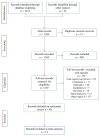Risk Factors for Abdominal Aortic Aneurysm in Population-Based Studies: A Systematic Review and Meta-Analysis
- PMID: 30544688
- PMCID: PMC6313801
- DOI: 10.3390/ijerph15122805
Risk Factors for Abdominal Aortic Aneurysm in Population-Based Studies: A Systematic Review and Meta-Analysis
Abstract
Abdominal aortic aneurysm (AAA) represents an important public health problem with a prevalence between 1.3% and 12.5%. Several population-based randomized trials have evaluated ultrasound screening for AAA providing evidence of a reduction in aneurysm-related mortality in the screened population. The aim of our study was to perform a systematic review and meta-analysis of the risk factors for AAA. We conducted a systematic review of observational studies and we performed a meta-analysis that evaluated the following risk factors: gender, smoking habits, hypertension, coronary artery disease and family history of AAA. Respect to a previous a meta-analysis we added the funnel plot to examine the effect sizes estimated from individual studies as measure of their precision; sensitivity analysis to check the stability of study findings and estimate how the overall effect size would be modified by removal of one study; cumulative analysis to evaluate the trend between studies in relation to publication year. Abdominal aortic aneurysm prevalence is higher in smokers and in males. On the other hand, while diabetes is a risk factor for many cardiovascular diseases, it is not a risk factor for AAA. In addition, it is important to underline that all countries, where AAA screening was set up, had high income level and the majority belong to Western Europe (United Kingdom, Sweden, Italy, Poland, Spain and Belgium). Abdominal aortic aneurysm screening is fundamental for public health. It could avoid deaths, ruptures, and emergency surgical interventions if abdominal aortic aneurysm was diagnosed early in the population target for screening.
Keywords: abdominal aortic aneurysm; meta-analysis; observational studies; risk factors.
Conflict of interest statement
The authors declare no conflict of interest.
Figures







References
-
- Moll F.L., Powell J.T., Fraedrich G., Verzini F., Haulon S., Waltham M., van Herwaarden J.A., Holt P.J., van Keulen J.W., Rantner B., et al. European Society for Vascular Surgery. Management of abdominal aortic aneurysms clinical practice guidelines of the European society for vascular surgery. Eur. J. Vasc. Endovasc. Surg. 2011;41(Suppl. 1):S1–S58. doi: 10.1016/j.ejvs.2010.09.011. - DOI - PubMed
-
- Krumholz H.M., Keenan P.S., Brush J.E., Jr., Bufalino V.J., Chernew M.E., Epstein A.J., Heidenreich P.A., Ho V., Masoudi F.A., Matchar D.B., et al. Standards for measures used for public reporting of efficiency in health care: A scientific statement from the American Heart Association Interdisciplinary Council on Quality of Care and Outcomes research and the American College of Cardiology Foundation. J. Am. Coll. Cardiol. 2008;52:1518–1526. doi: 10.1016/j.jacc.2008.09.004. - DOI - PubMed
-
- Makrygiannis G., Labalue P., Erpicum M., Schlitz M., Seidel L., El Hachemi M., Gangolf M., Albert A., Defraigne J.O., Lindholt J.S., et al. Extending abnominal aortic aneurysm detection to older age older age groups: Preliminary results from the Liege screening programme. Ann. Vasc. Surg. 2016;36:55–63. doi: 10.1016/j.avsg.2016.02.034. - DOI - PubMed
-
- Institute for Health Metrics and Evaluation Global Burden of Disease Study. [(accessed on 30 June 2018)]; Available online: http//www.healthmetricsandevaluation.org/gbd/visualizations/gbd-cause-pa....
Publication types
MeSH terms
LinkOut - more resources
Full Text Sources
Medical

